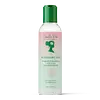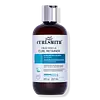What's inside
What's inside
 Key Ingredients
Key Ingredients

 Benefits
Benefits

 Concerns
Concerns

 Ingredients Side-by-side
Ingredients Side-by-side

Glycerin
HumectantPropanediol
SolventOlea Europaea Fruit Oil
MaskingPEG-40 Hydrogenated Castor Oil
EmulsifyingRosmarinus Officinalis Leaf Oil
MaskingHoney
HumectantRosmarinus Officinalis Flower/Leaf/Stem Extract
MaskingWater
Skin ConditioningLactic Acid
BufferingGlycolic Acid
BufferingVaccinium Myrtillus Fruit Extract
Skin ConditioningSaccharum Officinarum Extract
MoisturisingCitric Acid
BufferingCitrus Aurantium Dulcis Fruit Extract
MaskingCitrus Limon Fruit Extract
MaskingAcer Saccharum Extract
Skin ConditioningTartaric Acid
BufferingMalic Acid
BufferingMentha Piperita Oil
MaskingPhenoxyethanol
PreservativeEthylhexylglycerin
Skin ConditioningCI 77288
Cosmetic ColorantCurcuma Longa Root Extract
MaskingSpirulina Platensis Extract
Skin ProtectingGlycerin, Propanediol, Olea Europaea Fruit Oil, PEG-40 Hydrogenated Castor Oil, Rosmarinus Officinalis Leaf Oil, Honey, Rosmarinus Officinalis Flower/Leaf/Stem Extract, Water, Lactic Acid, Glycolic Acid, Vaccinium Myrtillus Fruit Extract, Saccharum Officinarum Extract, Citric Acid, Citrus Aurantium Dulcis Fruit Extract, Citrus Limon Fruit Extract, Acer Saccharum Extract, Tartaric Acid, Malic Acid, Mentha Piperita Oil, Phenoxyethanol, Ethylhexylglycerin, CI 77288, Curcuma Longa Root Extract, Spirulina Platensis Extract
Water
Skin ConditioningPropanediol
SolventHelianthus Annuus Seed Extract
Skin ConditioningHydrolyzed Corn Starch
HumectantCorn Starch Modified
AbsorbentArgania Spinosa Kernel Oil
EmollientCitrullus Lanatus Seed Oil
EmollientRibes Nigrum Seed Oil
EmollientPanthenol
Skin ConditioningHelianthus Annuus Seed Oil
EmollientPvp
Emulsion StabilisingCocos Nucifera Seed Butter
Skin ConditioningNiacinamide
SmoothingSqualane
EmollientGlycerin
HumectantC9-12 Alkane
SolventCoco-Caprylate/Caprate
EmollientBehentrimonium Chloride
PreservativeCaesalpinia Spinosa Gum
Skin ConditioningPolyacrylate Crosspolymer-6
Emulsion StabilisingTocopherol
AntioxidantLaureth-2
CleansingPentylene Glycol
Skin ConditioningSodium Gluconate
Skin ConditioningSodium Hydroxide
BufferingCitric Acid
BufferingEthylhexylglycerin
Skin ConditioningPhenoxyethanol
PreservativeSodium Benzoate
MaskingPotassium Sorbate
PreservativeParfum
MaskingLimonene
PerfumingLinalool
PerfumingCitronellol
PerfumingAlpha-Terpinene
PerfumingDimethyl Phenylethyl Carbinyl Acetate
PerfumingTetramethyl Acetyloctahydronaphthalenes
MaskingCitrus Limon Peel Oil
MaskingCitrus Aurantium Peel Oil
Pinene
MaskingRose Ketone-4
PerfumingVanillin
MaskingWater, Propanediol, Helianthus Annuus Seed Extract, Hydrolyzed Corn Starch, Corn Starch Modified, Argania Spinosa Kernel Oil, Citrullus Lanatus Seed Oil, Ribes Nigrum Seed Oil, Panthenol, Helianthus Annuus Seed Oil, Pvp, Cocos Nucifera Seed Butter, Niacinamide, Squalane, Glycerin, C9-12 Alkane, Coco-Caprylate/Caprate, Behentrimonium Chloride, Caesalpinia Spinosa Gum, Polyacrylate Crosspolymer-6, Tocopherol, Laureth-2, Pentylene Glycol, Sodium Gluconate, Sodium Hydroxide, Citric Acid, Ethylhexylglycerin, Phenoxyethanol, Sodium Benzoate, Potassium Sorbate, Parfum, Limonene, Linalool, Citronellol, Alpha-Terpinene, Dimethyl Phenylethyl Carbinyl Acetate, Tetramethyl Acetyloctahydronaphthalenes, Citrus Limon Peel Oil, Citrus Aurantium Peel Oil, Pinene, Rose Ketone-4, Vanillin
Ingredients Explained
These ingredients are found in both products.
Ingredients higher up in an ingredient list are typically present in a larger amount.
Citric Acid is an alpha hydroxy acid (AHA) naturally found in citrus fruits like oranges, lemons, and limes.
Like other AHAs, citric acid can exfoliate skin by breaking down the bonds that hold dead skin cells together. This helps reveal smoother and brighter skin underneath.
However, this exfoliating effect only happens at high concentrations (20%) which can be hard to find in cosmetic products.
Due to this, citric acid is usually included in small amounts as a pH adjuster. This helps keep products slightly more acidic and compatible with skin's natural pH.
In skincare formulas, citric acid can:
While it can provide some skin benefits, research shows lactic acid and glycolic acid are generally more effective and less irritating exfoliants.
Most citric acid used in skincare today is made by fermenting sugars (usually from molasses). This synthetic version is identical to the natural citrus form but easier to stabilize and use in formulations.
Read more about some other popular AHA's here:
Learn more about Citric AcidEthylhexylglycerin (we can't pronounce this either) is commonly used as a preservative and skin softener. It is derived from glyceryl.
You might see Ethylhexylglycerin often paired with other preservatives such as phenoxyethanol. Ethylhexylglycerin has been found to increase the effectiveness of these other preservatives.
Glycerin is already naturally found in your skin. It helps moisturize and protect your skin.
A study from 2016 found glycerin to be more effective as a humectant than AHAs and hyaluronic acid.
As a humectant, it helps the skin stay hydrated by pulling moisture to your skin. The low molecular weight of glycerin allows it to pull moisture into the deeper layers of your skin.
Hydrated skin improves your skin barrier; Your skin barrier helps protect against irritants and bacteria.
Glycerin has also been found to have antimicrobial and antiviral properties. Due to these properties, glycerin is often used in wound and burn treatments.
In cosmetics, glycerin is usually derived from plants such as soybean or palm. However, it can also be sourced from animals, such as tallow or animal fat.
This ingredient is organic, colorless, odorless, and non-toxic.
Glycerin is the name for this ingredient in American English. British English uses Glycerol/Glycerine.
Learn more about GlycerinPhenoxyethanol is a preservative that has germicide, antimicrobial, and aromatic properties. Studies show that phenoxyethanol can prevent microbial growth. By itself, it has a scent that is similar to that of a rose.
It's often used in formulations along with Caprylyl Glycol to preserve the shelf life of products.
Propanediol is an all-star ingredient. It softens, hydrates, and smooths the skin.
It’s often used to:
Propanediol is not likely to cause sensitivity and considered safe to use. It is derived from corn or petroleum with a clear color and no scent.
Learn more about PropanediolWater. It's the most common cosmetic ingredient of all. You'll usually see it at the top of ingredient lists, meaning that it makes up the largest part of the product.
So why is it so popular? Water most often acts as a solvent - this means that it helps dissolve other ingredients into the formulation.
You'll also recognize water as that liquid we all need to stay alive. If you see this, drink a glass of water. Stay hydrated!
Learn more about Water